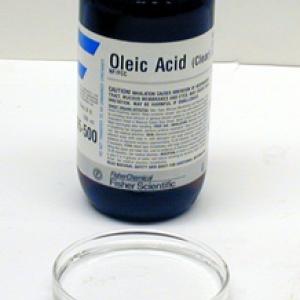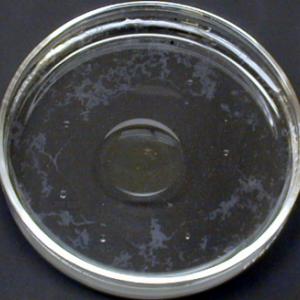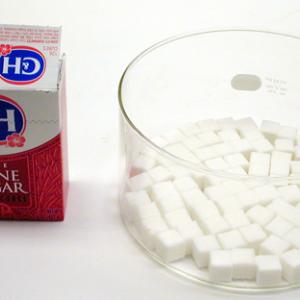College of Liberal Arts & Sciences
4D40.10 - Monomolecular Layer
Put some water into the petri dish and add several drops of Oleic Acid. Allow time for the layer to spread and then make approximate measurements to determine the diameter of the drop. Assuming the the oleic acid layer is only one molecule thick, calculations for molecular size, weight, volume, etc. may be made.
Fill the bottom of the pie plate with a single layer of sugar cubes. The total volume of the cubes is most easily done by measuring the space left by them in the box they came in. From this compute the height of layer. Use this to find the volume of a single cube and divide into the total volume of the layer to compute the number of cubes used. To compute the density of the cubes, divide the total given weight of the full box of sugar cubes by the internal dimensions of the box. From this the weight of a single cube can be determined.
This simulation can also be done using BB's and a graduated cylinder to measure a volume of BB's.
This method can also be used for the salt crystals. To actually measure the crystals, make a 35mm slide of salt crystals taped to a mm scale with transparent tape. All of these methods can be used to demonstrate how the oleic acid mono-layer experiment is done.
Lycopodium powder may be dusted onto the surface of the water so that the spot of oil can be clearly seen when using the overhead projector.
- Carlos H. Worner, "Units and Terms", "TPT, Vol. 50, # 1, Jan. 2012, p. 6.
- Beth Schaefer, Edward Collett, Anne Tabor-Morris, Joseph Croman, "An Estimation of the Number and Size of Atoms in a Printed Period", TPT, Vol. 49, # 7, Oct. 2011, p. 438.
- Roger F. Larson, "Laying the Foundation for the Size of a Molecule", TPT, Vol. 27, # 6, Sept. 1989, p. 458.
- P. Joseph Garcia and Stephen G. Wukovitz, "Before the Molecular Monolayer Experiment",TPT, Vol. 16, # 6, Sept. 1978, p. 379.
- Elmer L. Galley, "Preludes to the Monolayer Experiment", TPT, Vol. 4, # 1, Jan. 1966, p. 34.
- A. P. French, "Earliest Estimates of Molecular Size", AJP, Vol. 35, # 2, Feb. 1967, p. 162.
- Robert L. Grossman, "Unusual Wind Effect on a Lake-Surface Monolayer Film", Physics Today, Jan. 2015, p. 10.
- J. E. Greene, "Organic Thin Films: From Monolayers, on Liquids to Multilayers on Solids", Physics Today, June 2014, p. 43.
- Jearl Walker, "Funny Things Happen When Drops of Oil or Other Substances Are Placed on Water", The Amateur Scientist, December, 1983.
- Jearl Walker, "2.148, Slight Ridge on Moving Water", The Flying Circus of Physics Ed. 2, p. 144.
- W. Bolton, "The Size of a Molecule", Book I - Properties of Materials, Physics Experiments and Projects, 1968, p. 29.
- Julius Sumner Miller, Q61 & A61, Millergrams I – Some Enchanting Questions for Enquiring Minds, p. 42 & 98.
Disclaimer: These demonstrations are provided only for illustrative use by persons affiliated with The University of Iowa and only under the direction of a trained instructor or physicist. The University of Iowa is not responsible for demonstrations performed by those using their own equipment or who choose to use this reference material for their own purpose. The demonstrations included here are within the public domain and can be found in materials contained in libraries, bookstores, and through electronic sources. Performing all or any portion of any of these demonstrations, with or without revisions not depicted here entails inherent risks. These risks include, without limitation, bodily injury (and possibly death), including risks to health that may be temporary or permanent and that may exacerbate a pre-existing medical condition; and property loss or damage. Anyone performing any part of these demonstrations, even with revisions, knowingly and voluntarily assumes all risks associated with them.


